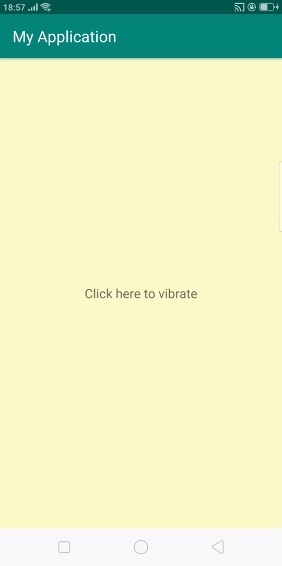如何使Android裝置振動?
在Android中,使用振動服務,我們可以使Android手機振動。此示例演示瞭如何使Android裝置振動。
步驟 1 - 在Android Studio中建立一個新專案,轉到檔案⇒新建專案,並填寫所有必需的詳細資訊以建立新專案。
步驟 2 - 將以下程式碼新增到res/layout/activity_main.xml。
<?xml version="1.0" encoding="utf-8"?> <LinearLayout xmlns:android="http://schemas.android.com/apk/res/android" android:id="@+id/parent" xmlns:tools="http://schemas.android.com/tools" android:layout_width="match_parent" android:layout_height="match_parent" tools:context=".MainActivity" android:gravity="center" android:background="#33FFFF00" android:orientation="vertical"> <TextView android:id="@+id/text" android:textSize="18sp" android:text="Click here to vibrate" android:layout_width="wrap_content" android:layout_height="wrap_content" /> </LinearLayout>
在以上程式碼中,我們使用了TextView,當你點選TextView時,它會振動。
步驟 3 - 將以下程式碼新增到src/MainActivity.java
package com.example.andy.myapplication;
import android.content.Context;
import android.content.Intent;
import android.os.Build;
import android.os.Bundle;
import android.os.VibrationEffect;
import android.os.Vibrator;
import android.support.v7.app.AppCompatActivity;
import android.view.View;
import android.widget.LinearLayout;
import android.widget.TextView;
import android.widget.Toast;
public class MainActivity extends AppCompatActivity {
int view = R.layout.activity_main;
TextView textView;
@Override
protected void onCreate(Bundle savedInstanceState) {
super.onCreate(savedInstanceState);
setContentView(view);
final LinearLayout parent = findViewById(R.id.parent);
textView = findViewById(R.id.text);
textView.setOnClickListener(new View.OnClickListener() {
@Override
public void onClick(View v) {
Vibrator vibrator = (Vibrator) getSystemService(Context.VIBRATOR_SERVICE);
if (Build.VERSION.SDK_INT >= Build.VERSION_CODES.O) {
vibrator.vibrate(VibrationEffect.createOneShot(500, VibrationEffect.DEFAULT_AMPLITUDE));
} else {
vibrator.vibrate(500);
}
}
});
}
}在以上程式碼中,我們使用了振動服務,它是一個系統服務,如下所示 -
Vibrator vibrator = (Vibrator) getSystemService(Context.VIBRATOR_SERVICE);
if (Build.VERSION.SDK_INT >= Build.VERSION_CODES.O) {
vibrator.vibrate(VibrationEffect.createOneShot(500, VibrationEffect.DEFAULT_AMPLITUDE));
} else {
vibrator.vibrate(500);
}在以上程式碼中,我們設定了500毫秒,所以它會持續振動500毫秒。
步驟 4 - 將以下程式碼新增到manifest.java
<?xml version="1.0" encoding="utf-8"?> <manifest xmlns:android="http://schemas.android.com/apk/res/android" package="com.example.andy.myapplication"> <uses-permission android:name="android.permission.VIBRATE" /> <application android:allowBackup="true" android:icon="@mipmap/ic_launcher" android:label="@string/app_name" android:roundIcon="@mipmap/ic_launcher_round" android:supportsRtl="true" android:theme="@style/AppTheme"> <activity android:name=".MainActivity" android:screenOrientation="portrait"> <intent-filter> <action android:name="android.intent.action.MAIN" /> <category android:name="android.intent.category.LAUNCHER" /> </intent-filter> </activity> </application> </manifest>
在以上程式碼中,我們添加了振動使用者許可權,沒有許可權,它將無法振動。
讓我們嘗試執行您的應用程式。我假設您已將您的實際Android手機裝置連線到您的計算機。要從Android Studio執行應用程式,請開啟專案中的一個活動檔案,然後點選執行 ![]() 工具欄中的圖示。選擇您的手機裝置作為選項,然後檢查您的手機裝置,它將顯示您的預設螢幕 -
工具欄中的圖示。選擇您的手機裝置作為選項,然後檢查您的手機裝置,它將顯示您的預設螢幕 -

在以上結果中,當你點選TextView時,它會振動500毫秒。
點選這裡下載專案程式碼

廣告

 資料結構
資料結構 網路
網路 RDBMS
RDBMS 作業系統
作業系統 Java
Java iOS
iOS HTML
HTML CSS
CSS Android
Android Python
Python C 程式設計
C 程式設計 C++
C++ C#
C# MongoDB
MongoDB MySQL
MySQL Javascript
Javascript PHP
PHP